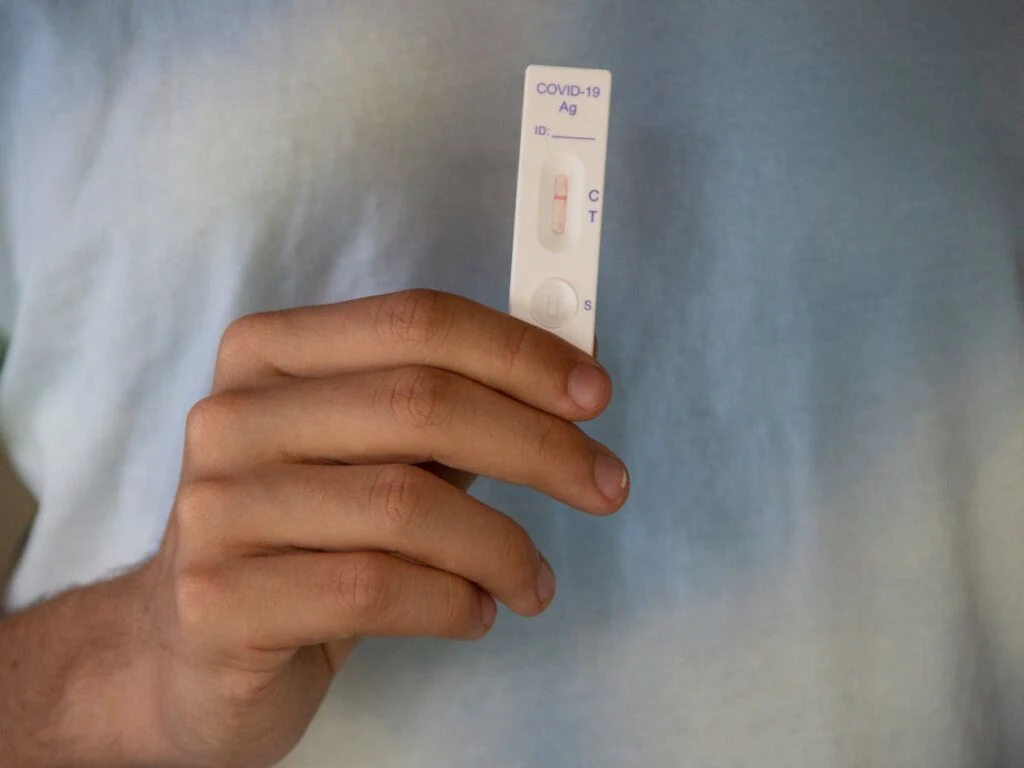Something unexpected started appearing in search engines worldwide. People began typing “razor blade throat” into Google at alarming rates, describing a pain so sharp it felt like swallowing broken glass. Medical professionals noticed the pattern immediately – patients flooding clinics with complaints about throat pain, unlike anything they’d experienced before.
Behind these searches lies a new reality that health experts hoped we’d left behind. A variant has emerged that’s spreading faster than its predecessors, carrying a signature symptom that’s impossible to ignore. While the medical community scrambles to understand its full implications, one thing becomes clear: we’re not done with COVID yet.
“Nimbus” – The Latest Unwelcome Guest
NB.1.8.1 officially earned its designation as a “variant under monitoring” from the World Health Organization in May 2025. Medical communities and the public quickly dubbed it “Nimbus,” a name that somehow captures its swift, cloud-like spread across continents.
First detected in January 2025, Nimbus originated from the Omicron lineage, specifically from the recombinant variant XDV.1.5.1. What seemed like a minor genetic shift rapidly became a global concern as the variant established dominance in multiple countries.
Numbers tell a striking story of rapid expansion. The global prevalence jumped from 2.5% to 10.7% within four weeks, representing one of the fastest variant spreads scientists have documented since the pandemic’s early days. Currently detected across 22 countries, Nimbus shows no signs of slowing its worldwide journey.
“Razor Blade Throat” Takes Center Stage

Online search patterns revealed something unprecedented about the impact of this variant. Google searches for “razor blade throat” surged dramatically, suggesting people were experiencing throat pain far beyond typical COVID symptoms.
Patients describe the sensation as uniquely severe – not just the familiar scratchiness of a common cold, but a sharp, cutting pain that makes swallowing excruciating. Medical professionals report that complaints of throat pain have increased in both frequency and intensity since Nimbus began circulating.
Pain intensity distinguishes this variant from typical seasonal illnesses. While previous COVID strains caused sore throats, the sheer severity of throat symptoms with Nimbus marks a notable departure from established patterns.
Healthcare workers note that patients specifically mention the quality of pain rather than just its presence. Descriptions consistently reference cutting, slicing, or blade-like sensations that significantly interfere with basic functions, such as eating and drinking.
Familiar Symptoms Make Their Return
Beyond the signature throat pain, Nimbus carries the familiar constellation of COVID symptoms that have become all too recognizable. Cough remains the primary respiratory complaint, often dry and persistent, causing significant discomfort for patients.
Congestion affects the nasal passages and sinuses, causing pressure and making it difficult to breathe through the nose. Headaches affect people of all ages, ranging from mild pressure to severe pain that interferes with daily activities.
Fatigue remains the most common complaint among individuals infected with the virus. Many describe exhaustion that goes beyond normal tiredness, leaving them unable to perform routine tasks without significant effort.
Fever may present in some cases, but it isn’t universal among all patients. When present, temperatures typically range from mild to moderate, though individual responses vary considerably.
Gastrointestinal symptoms, including nausea and diarrhea, affect a notable portion of patients. Muscle aches and body pain frequently accompany respiratory symptoms, creating a comprehensive feeling of illness that can last for days or weeks.
Symptoms Vary By Person and Vaccination Status

Individual responses to Nimbus infection differ significantly between patients, making prediction challenging for healthcare providers. Vaccination history plays a substantial role in determining both symptom severity and duration of illness.
Age groups experience different symptom patterns, with older adults typically facing more severe presentations while children often show milder symptoms. Underlying health conditions substantially affect how the variant manifests in other individuals.
Previous COVID infections may alter the current symptom experience, although scientists continue to study how prior immunity influences the presentation of Nimbus. WHO confirms that current vaccines still provide decent protection against severe outcomes.
Dr. Naveed Asif, GP at London General Practice, explained the variant’s spread: “Its spread has been identified in around 22 countries. WHO assesses the additional risk to the global public as currently low, and existing COVID-19 vaccines are considered effective in preventing severe disease.”
Distinguishing COVID From Other Summer Ailments
Summer timing complicates diagnosis, as hay fever symptoms substantially overlap with those of viral infections. Seasonal allergies can produce symptoms such as cough, congestion, and fatigue that closely mimic those of COVID-19, making differentiation difficult without testing.
Common cold viruses circulate year-round regardless of season, adding another layer of diagnostic complexity. Southern Hemisphere flu season further complicates the picture, as multiple respiratory viruses present nearly identical symptoms.
Multiple respiratory illnesses can simultaneously circulate in communities, making symptom-based diagnosis unreliable. Only positive COVID-19 tests can definitively confirm an actual infection, although testing availability varies significantly between regions.
Professional medical advice becomes crucial when symptoms include shortness of breath or severe throat pain that interferes with swallowing. Healthcare providers can distinguish between different respiratory illnesses through clinical evaluation and appropriate testing.
Nimbus Spreads Faster Than Its Predecessors

Laboratory studies reveal why Nimbus transmits more effectively than earlier variants. Research shows the variant exhibits stronger binding to human ACE2 receptors, the cellular entry points that SARS-CoV-2 uses to infect cells.
Dr. Chun Tang from UK private healthcare centre Pall Mall Medical provided insight into the variant’s characteristics: “NB.1.8.1 isn’t too different from the Omicron variant, but it does have some tweaks to its spike protein, which might make it spread a bit more easily or slip past some of our existing immunity.”
Enhanced transmission capability allows Nimbus to establish dominance more quickly than its predecessors. By late April, the variant had achieved dominance in Hong Kong and China, demonstrating its competitive advantage over other circulating strains.
Notable increases were observed in India, Singapore, and Thailand, demonstrating the variant’s ability to spread across diverse populations and climates. Better immune evasion than some previous strains contributes to its transmission success, allowing reinfection of previously immune individuals.
Research indicates a 1.5-1.6 fold reduction in antibody neutralization compared to LP.8.1.1, meaning existing immunity provides somewhat less protection against Nimbus than against earlier variants.
No Evidence of Increased Severity
Current data provides reassurance that Nimbus doesn’t cause more severe disease than previous variants. Hospital admissions have risen in areas where the variant circulates widely, but increases correlate with transmission rates rather than individual case severity.
ICU admission rates remain consistent with patterns seen during earlier variant waves. Death rates show no concerning increases that would suggest Nimbus causes more dangerous illnesses than its predecessors.
WHO maintains a low additional public health risk assessment for the variant, indicating that global health authorities don’t consider it significantly more threatening than other circulating strains. Antiviral treatments remain effective against Nimbus, providing healthcare providers with established tools for managing severe cases of the disease.
While throat pain may be more severe, the overall progres
sion of the disease appears similar to that of other Omicron subvariants. Most patients recover at home with supportive care, following patterns established during previous waves of the pandemic.
Vaccine Protection Remains Strong

Current COVID vaccines continue to provide robust protection against severe outcomes. JN.1-targeted vaccine updates offer good cross-protection, as the variant shares significant genetic similarities with previously targeted strains.
Monovalent KP.2 and LP.8.1 vaccines demonstrate similar efficacy against Nimbus in laboratory studies. Breakthrough infections remain possible, but vaccines maintain their primary function of preventing hospitalization and death.
Protection against severe disease remains the vaccines’ most substantial benefit, even as minor breakthrough infections may occur more frequently. Booster recommendations vary between countries based on local health policies and population risk assessments.
Major US Policy Changes Shake Up Recommendations
Health Secretary Robert F. Kennedy Jr. recently announced significant changes to US COVID vaccine guidance, eliminating recommendations for healthy children and pregnant women to receive boosters. The decision represents a unilateral policy shift made without input from an acting CDC director.
Michael Osterholm, director of the University of Minnesota’s Center for Infectious Disease Research and Policy, criticized the timing: “There’s no new data or information, just them flying by the seat of their pants.”
Previous CDC recommendations advised vaccination for everyone over six months old, making the US guidance among the most inclusive in the world. Kennedy’s announcement has raised questions about insurance coverage and whether the policy change signals further restrictions on access to vaccines.
When to Seek Medical Attention

Shortness of breath requires immediate professional evaluation regardless of other symptoms. A persistent high fever, particularly in vulnerable populations, warrants medical consultation to rule out potential complications.
Severe throat pain that interferes with swallowing or breathing needs prompt assessment, especially given Nimbus’s signature symptom profile. Worsening symptoms after initial improvement may indicate secondary infections or complications.
High-risk individuals should contact their healthcare providers early in the course of their illness. Telemedicine options offer accessible initial symptom evaluation while maintaining social distancing protocols.
Managing Symptoms at Home
Paracetamol, also known as acetaminophen, serves as a reliable ally in alleviating the discomforts associated with fever, pounding headaches, and pervasive body aches. It works effectively to lower body temperature and ease discomfort, providing much-needed relief during illness. To curb the spread of the Nimbus virus—characterized by its heightened transmissibility—it is crucial to isolate oneself from others. This precaution not only protects the individual but also safeguards the wider community.
Wearing masks during necessary interactions is essential in shielding family members and essential workers from potential exposure. Proper mask usage forms a barrier that significantly reduces the risk of transmission, becoming an indispensable tool in public health. Meanwhile, ensuring adequate rest is vital; it allows the body’s immune system to strengthen and recover, restoring vitality as it combats the infection. Staying well-hydrated is equally important, as it helps manage fever and alleviate congestion, providing comfort during recovery.



